In this article, you’ll learn what is power steering system? and how it works? its Types, Advantages, Disadvantages, and differences between Manual Steering vs Power Steering. Also, you can download the PDF file of this article at the end.
What is Power Steering System?
Power steering is a system that reduces the driver’s effort required for steering to turn the steering wheel. With the help of power steering, it easier for the vehicle to turn or maneuver.
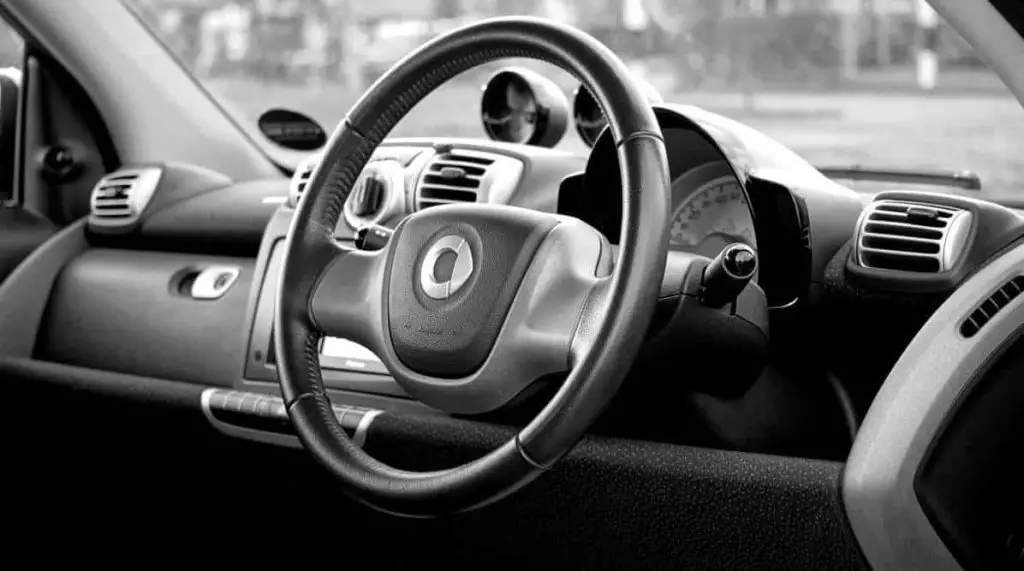
Working of Power Steering
The power steering unit is located at the lower end of the steering column in place of the usual conventional steering gear. It is connected by two oil lines to the hydraulic pump mounted on the generator. The pump with a relief valve avoids excessive oil pressures.
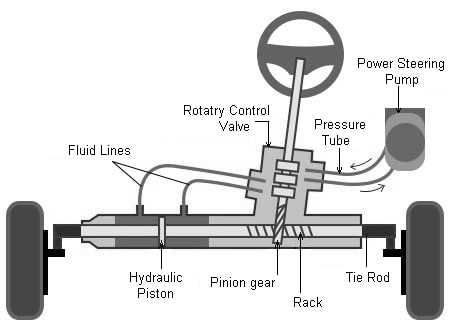
The power steering unit has:
- A valve body with four valves.
- Two power cylinders have pistons one on each side.
The Valves will deliver the oil to help in making a turn. This works on the endwise movement of the steering column shaft. The steering wheel rotates the worm. Thus it imposes end-wise thrust (either up or down) on the worm as per the direction of rotation. This creates the movement of the steering column shaft through a small fraction of an inch.
As the valve is integral with the shaft, moves in the valve body. This action admits oil under pressure in one or the other end of the power cylinder. This makes the piston move in one or another direction. This motion is carried to the pitman shaft through the rack and pinion arrangement.
Types of Power Steering System
There are generally five types of power steering systems:
- Integral power steering
- Linkage power steering
- Hydraulic Power Steering
- Electric Power Steering
- Electro-hydraulic Power Steering
1. Integral Power Steering
Integral power steering is made to receive power assistance when effort on the steering wheel rim exceeds two pounds and up to five pounds.
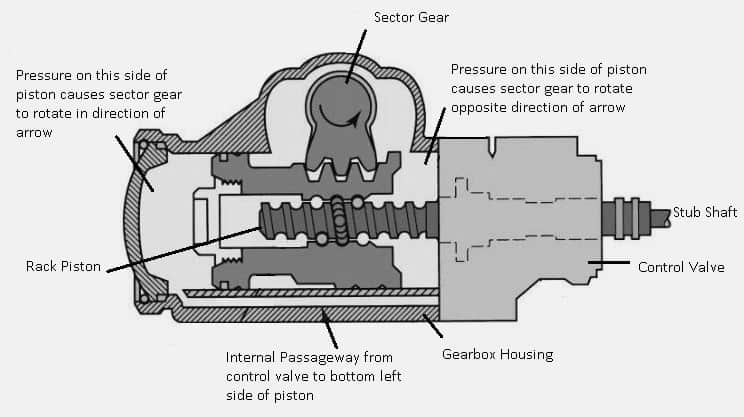
It consists of a worm-and-ball bearing nut steering gear with a hydraulic rack piston centered along the worm shaft, which can assist in moving the nut in any direction through hydraulic pressure.
A reaction contact valve is linked to the worm shaft thrust bearing through a link and actuator lever. Any moment of the thrust bearing causes the control valve to move which opens and closes the oil passage between the valve body and the housing of the gear and pinion assembly.
Working:
The working of the integral power steering is shown in the figure. When the vehicle is going straight ahead, the oil flows from the pump, through the open center of the valves, and back to the reservoir.
It also flows into the areas on both sides of the rack piston to act as a lubricant and to cushion the road shocks. These areas are sometimes called “power cylinders”.
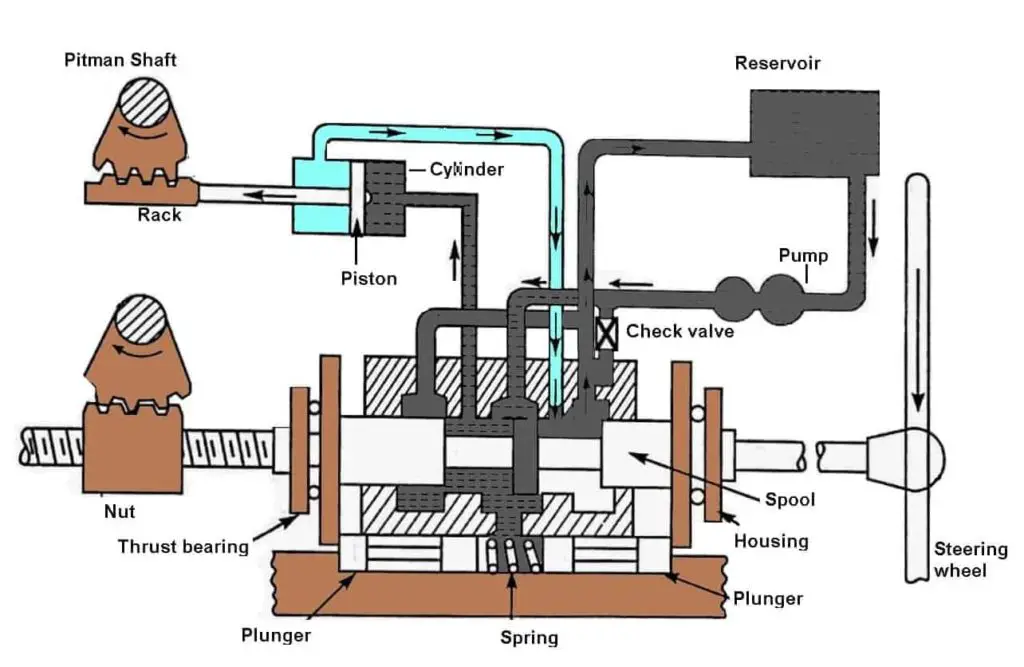
When the vehicle is turned to the right, the worm moves slightly down to the left, with the reaction of the wheels, pitman shaft sector, steering linkage, and turning of the worm to the ball nut.
The movement forces the worm against the thrust bearing and causes the actuating lever and control valve links to move the control valve to the position shown in the figure. The fluid passage to the right turn cylinder is broadened, while flow to the left turn cylinder is made narrower.
Thus the flow of fluid from the pump is restricted and the pump pressure is built on the right side of the rack position, causing the ball nut to move on the right side. The fluid in the left turn power cylinder is forced to the pump reservoir through the return line.
When the vehicle has to take a left turn, the worm causes the fluid to enter the left-turn power cylinder in greater quantities and empty the right-turn cylinder. This effect makes the rack piston and ball nut move in the left-turn direction.
2. Linkage Power Steering
In this type of power steering, the power cylinder is not part of the steering gear. It is connected to the steering linkage. The valve assembly is tilted into the steering linkage, either as a separate assembly or integrally with the power cylinder. The power assistance is applied directly to the steering linkage.
The figure shows one design of the linkage power steering. In the neutral position, that is, when the vehicle is running straight ahead, a spool valve in the control valve assembly is held in the center position by means of a centering spring. The oil flows to both sides of the power cylinder and around the valve band and returns to the pump reservoir.
Working:
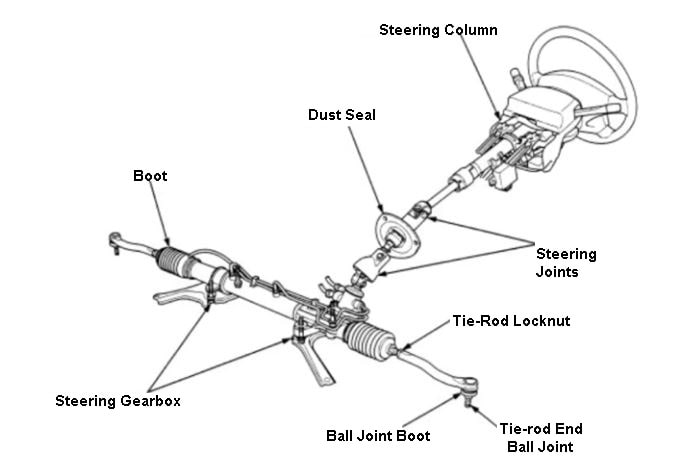
When the vehicle is turning to the left, and the force on the wheel exceeds four pounds, Pitman’s arm moves the spool control valve with sufficient force to remove the pressure of the centering spring so that the valve slides to the right side of the valve body.
In this position, it connects the left-hand side of the power cylinder to the return line leading to the pump reservoir and directs oil pressure to the right-hand side of the power cylinder. This causes the cylinder housing to move to the right, which moves the relay rod to the right in order to turn the wheels to the left.
When the vehicle is taking a right turn, the condition is reversed and the relay rod is forced to turn the wheels to the right.
Read also: What is Quadra or Four Wheel Steering System? How it Works?
3. Hydraulic Power Steering
This type of power steering practiced from the 1950s to 2000s was hydraulic assistance. There are some downsides to this type of system, it wastes energy, as the pump is running continuously, even when the vehicle is running directly and no further assistance is required.
In this hydraulic system with hydraulic pumps driven by engines and hydraulic cylinders are utilized to increase the steering wheel input force which decreases the effort required to drive the front wheels of the vehicle.
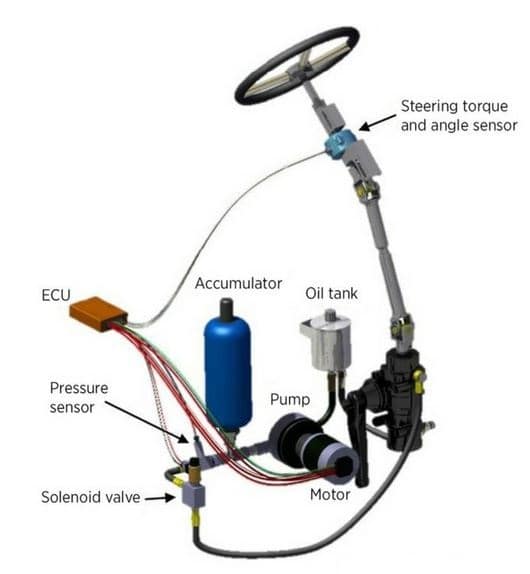
Working:
When the operator gives input by rotating the steering wheel, the hydraulic pump driven by the engine starts pumping the compressed hydraulic fluid by means of lines. The hydraulic pressure given by the pump inserts the hydraulic cylinder which applies pressure to the piston.
Now the piston which is in high pressure begins moving from one end to the other which pushes the fluid forward through the forward lines, with this action of the piston the input force exerted by the driver is repeated many times.
The high-pressure fluid carried by the hydraulic cylinder then exerts pressure on the connected pinion via a coupling mechanism that applies force to the rack gear and the steering action occurs in the front wheels.
- Read also: What are different types of steering gears?
4. Electric Power Steering
Electric power steering (EPS) is the model in today’s new cars. It is the most advanced type of power steering system. In this, the hydraulic system is fully restored with electric motors and sensors from hydraulic power steering.
Rather than using hydraulic force, the motor powered by the vehicle’s battery uses the force on the steering gear. The steering gear and torque provided by the motor are controlled by the sensor detecting the position of the steering column.
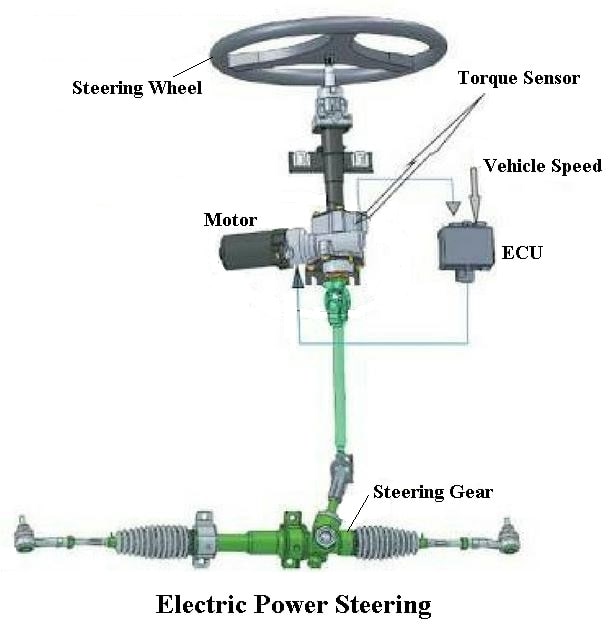
Working:
When the driver provides the input through the steering wheel, the electronic sensors connected to the steering column read the input and send them to the vehicle’s electric control unit.
The vehicle’s ECU analyzes these inputs and gives a voltage signal to the electric motor located at the end of the steering column that gears are in a continuous mesh with the pinion gear.
These voltage signals sent by the ECU start the motor driven by the vehicle’s battery and provide special torque according to the value of the received voltage signals.
The motor is followed by a gear that is in constant mesh with the pinion gear, which begins to transmit manifold torque to the pinion gear which uses torque to the rack through which it is connected. With this torque mounted by the pinion on the rack, the rack moves which rotates the front wheels as required.
5. Electro-hydraulic Power Steering
Among the hydraulic and electric types of power steering, there is a hybrid of the two systems known as electrohydraulic. It works like a hydraulic-assist system, only the hydraulic motor is produced by an electric motor rather than running the pump from the engine.
This relieves the previously reported wasted-energy complaint but does not allow all possible features with electric power steering. Only a few vehicles currently use this system, including some heavy pickup trucks.
Manual Steering Vs Power Steering
What is the difference between the manual steering and power steering system:
Power steering is a system that helps in steering the wheels utilizing the source of power. Whereas Manual steering is a system in which manual force is utilized for steering.
The mechanism used in power steering is hydraulic and electric power. The hydraulic power steering contains rack and pinion, recirculating ball and nut, worm and roller, hydrostatic and electric power steering contains Rack and pinion, column driven EPS, pinion driven EPS, Rack driven EPS. Manual steering, uses a rack and pinion, worm and roller, and recirculation ball and nut.
The elements used in power steering is a hydraulic pump, fluid reservoir, hoses, lines; and either a power assist unit mounted on or integral with, a power steering gear assembly. Whereas manual steering has a steering wheel and column, a manual gearbox and rack & pinion assembly, steering knuckles and ball joints, and the wheel spindle assemblies.
Power steering has a quick response. As compared to manual steering, it has a slow response.
The resistance to wheel movement of the power steering is less. As compared to manual steering, the resistance to move movement is more.
Power steering is preferred in heavyweight vehicles. As compared to manual steering, it is preferred in low-weight vehicles.
The benefits of using power steering are Absorbs road shocks, minimum efforts, greater safety, and controllability under critical situations. Manual steering provides a mechanical connection between steering and wheel all the components remain to be fixed without the help of the auxiliary power and are preferred in race cars.
Advantages of Power Steering
Following are the advantages of power steering:
- It prevents the wheel from transferring the loading to the steering column.
- Power steering reduces driver fatigue.
- It lowers the input torque and continuous steering function.
- In power steering, the oil output is directly proportional to steer speed.
Disadvantages of Power Steering
Following are the disadvantages of power steering:
- The design of the power steering is complicated.
- Power steering is costly than the manual steering
- It has a fluid leakage problem.
Conclusion
In vehicles, a power steering system helps operators to steer the vehicle by increasing the steering force required to turn the steering wheel, making it easier for the vehicle to turn or move.
As we have already discussed all the different “types of power steering system” with its working but still if you have any questions you can ask in the comments. If you have liked this article then please share it with your friends.
Want free PDFs in your inbox? Then subscribe to your newsletter.
Download PDF file of this article:
You might like to read more in our blog:
- What is Piston: Parts, Types of Pistons and Working Principle with [PDF]
- What is Torque Converter as a Fluid Coupling: How It Works?
- 9 Different Types of Clutches and How they Work?
External Resources:
Hi, thanks for the info, very informative. Please send me the link for download.
You’re welcome. The PDF file has been sent to your inbox.
Thanks for information of power steering system
Please send the link
The PDF file has been sent to your inbox.
Very helpful. Thanks for the info.
You’re welcome.
Please send the pdf
The PDF file has been sent to your inbox.
You’re welcome.
Please send me the link to download
I have updated the article with the PDF file, you can download it now.